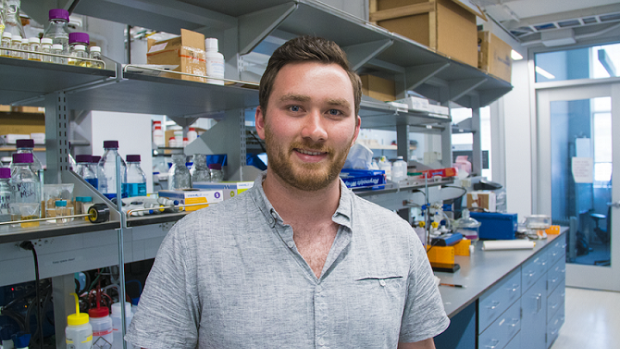NYU Tandon Student Wins U.S. DOE Grant to Conduct Research at Lawrence Berkeley National Lab

Adlai B Katzenberg received the competitive U.S. Department of Energy (DOE) Office of Science Graduate Student Research (SCGSR) Program grant.
Assistant Professor of Chemical and Biomolecular Engineering Miguel Modestino is committed to introducing solar processes into the chemical industry, replacing fossil fuel-intensive practices with sustainable methods that rely on biomass feedstocks and solar energy. His team’s research lies at the interface of multifunctional material development and electrochemical engineering since electrochemical devices are ubiquitous in a broad range of energy conversion technologies and chemical processes.
Last year Modestino garnered a Global Change Award from the H&M Foundation in recognition of his efforts to create sustainable textiles, as well as a spot on MIT Technology Review’s Latin American “Innovators under 35” list.
Now, one of his doctoral students, Adlai B Katzenberg, is also accruing laurels. Katzenberg was recently tapped to take part in the competitive U.S. Department of Energy (DOE) Office of Science Graduate Student Research (SCGSR) Program, which is aimed at encouraging research critically important to the nation’s energy needs and goals. The award will enable him to work at the Lawrence Berkeley National Lab, an important component of our national laboratory system. Among the high-profile figures who have been associated with Lawrence Berkeley are more than a dozen Nobel laureates and an equally impressive number of National Medal of Science recipients; current researchers include dozens of members of the National Academy of Sciences, National Academy of Engineering, and other such groups.
A native of California, Katzenberg is happy for the chance to be closer to his family during his time in Berkeley, which will last from early September 2018 to the following January. He is eager, as well, to further his research with the help of the Advanced Light Source, a Berkeley synchrotron that can emit the high-intensity radiation needed to study the structure of the ion-conducting polymers he has synthesized here at Tandon in the process of discovering new materials and methods for energy conversion and storage.
“I’ll be working to gain insight into the relationship between chemical structure, physical structure, and transport properties in perfluorinated sulfonic acid (PFSA) ionomers, since those are the most common materials used in the Proton Exchange Membranes (PEM) of electrochemical energy conversion devices like fuel cells,” he explains. “The synchrotron at the national lab is in high demand, so it’s a privilege to be chosen to use it, and it will also be an honor to work alongside Berkeley researchers Ahmet Kusoglu and Adam Weber, who are well-known figures in this field and who have collaborated with Professor Modestino on other important studies.”




